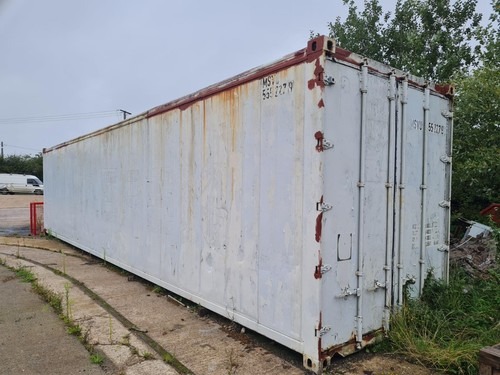An In-Depth Look Back A Trip Back In Time: What People Talked About Cargo Containers 20 Years Ago
The World of Cargo Containers: An Essential Component of Global Trade
Cargo containers have transformed the landscape of global trade and shipping since their creation in the mid-20th century. With their standardization, toughness, and capability to hold huge amounts of products, shipping containers have ended up being the foundation of global supply chains. This post will dive into the various aspects of cargo containers, including their types, history, benefits, and the obstacles faced in their use.
A Brief History of Cargo Containers
The principle of containerization was pioneered by Malcom McLean in the 1950s. Prior to this development, items were filled and unloaded individually from ships, resulting in ineffectiveness and increased expenses. cogcontainersltd.com was basic yet revolutionary: design a standardized container that might quickly be moved between different modes of transport, such as ships, trucks, and trains. This caused the first container ship trip in 1956 from Newark, New Jersey to Houston, Texas.
Considering that then, container shipping has actually experienced exponential growth. According to the United Nations Conference on Trade and Development (UNCTAD), the overall volume of containers delivered worldwide has increased from around 5 million TEUs (Twenty-foot Equivalent Units) in 1980 to roughly 200 million TEUs in 2020. This widespread adoption of standard-sized containers has actually assisted in trade on an unprecedented scale.
Types of Cargo Containers
Cargo containers can be found in different types, each created for specific functions. Below is a table summarizing the most common types of containers:
Container Type
Description
Requirement Dry Container
The most typical type, used for basic cargo. Offered in 20ft and 40ft sizes.
Refrigerated Container
Insulated and geared up with a cooling system to transport perishable goods. Offered in different sizes.
Flat Rack Container
Created for large cargo that can not fit into basic containers, such as equipment or automobiles.
Open Top Container
Similar to standard containers however with an open top, enabling filling high products.
Tank Container
Round tanks used for transporting liquids and gases.
Bulk Container
Developed for bulk cargo such as grains, coal, and minerals.
High Cube Container
Taller than standard containers, providing additional space for light, large cargo.
Advantages of Using Cargo Containers
Using cargo containers offers many advantages to shippers, manufacturers, and customers alike. Here are some key benefits:
Increased Efficiency: Containers can be filled and unloaded rapidly utilizing cranes and other machinery, reducing turnaround times for ships and reducing hold-ups in transit.
Standardization: With standardized dimensions, containers can be easily transferred between various modes of transport, facilitating smooth logistics.
Security and Protection: Cargo containers are developed to withstand extreme weather, tampering, and theft. They offer a safe environment to safeguard products during transit.
Cost-Effective: Container shipping tends to be more economical than other kinds of transport due to lowered labor costs and increased cargo capability on ships.
Intermodal Connectivity: Containers can be quickly transferred by truck, rail, and ship, offering flexibility in logistics and reducing expenses.
Environmental Sustainability: Containerization minimizes the carbon footprint of carrying goods by maximizing cargo capacity while lessening fuel intake per unit carried.
Difficulties in Cargo Container Use
While cargo containers have substantially streamlined global trade, they also present unique obstacles that the industry should attend to:
Container Shortages: Fluctuations in supply and need can cause scarcities, triggering hold-ups and increased expenses.
Inefficiencies in Container Movement: Containers frequently end up being stranded in ports or warehouses due to inadequate facilities or poor logistics management.
Environmental Impact: Despite being more efficient than older shipping approaches, the container shipping industry still contributes to carbon emissions and marine contamination.
Security Issues: While containers are protected, the hazard of smuggling and prohibited activities stays an issue, requiring comprehensive oversight and assessments.
Future Trends in Cargo Containers
The future of cargo containers is likely to be shaped by technological advancements and market innovations. Here are some patterns to enjoy:
Automation: Automated cranes and self-governing lorries are ending up being significantly typical in ports, enhancing efficiency and lowering labor costs.
Digitalization: The use of blockchain innovation for tracking container motions and enhancing transparency is anticipated to transform supply chain management.
Eco-Friendly Containers: Emerging patterns include developing biodegradable shipping materials and eco-efficient containers that reduce environmental effects.
Smart Containers: The combination of IoT sensing units in containers permits real-time tracking and monitoring of cargo conditions, enhancing security and reducing losses.
Often Asked Questions (FAQ)
1. What is the basic size of a cargo container?
- The most typical container sizes are 20ft and 40ft long, with a width of 8ft and a height of 8.5 ft (or 9.5 feet for High Cube containers).
2. How are cargo containers transported?
- Cargo containers can be moved using ships, trucks, and trains. They are created for simple transfer between these modes of transport, helping with intermodal logistics.
3. What kinds of goods can be transferred in cargo containers?
- Containers can transport nearly any kind of cargo, including perishables, machinery, customer products, and basic materials, depending upon the container type used.
4. Are cargo containers ecologically friendly?
- Container shipping is typically more eco-friendly compared to other transport methods due to its efficiency. Nevertheless, the market still faces difficulties concerning emissions and contamination.
5. What is a TEU?
- TEU represents Twenty-foot Equivalent Unit, which is a standard measure used to describe container capability. One TEU amounts to one 20ft container.
Cargo containers are essential to the performance of the global economy, enabling nations to trade efficiently and effectively. As the industry evolves, welcoming technological improvements and pursuing sustainability will be essential for satisfying the needs of future trade. Comprehending the intricacies of cargo containers is essential for anybody associated with logistics, transport, or worldwide trade and will contribute to navigating the obstacles and chances of an interconnected world.
